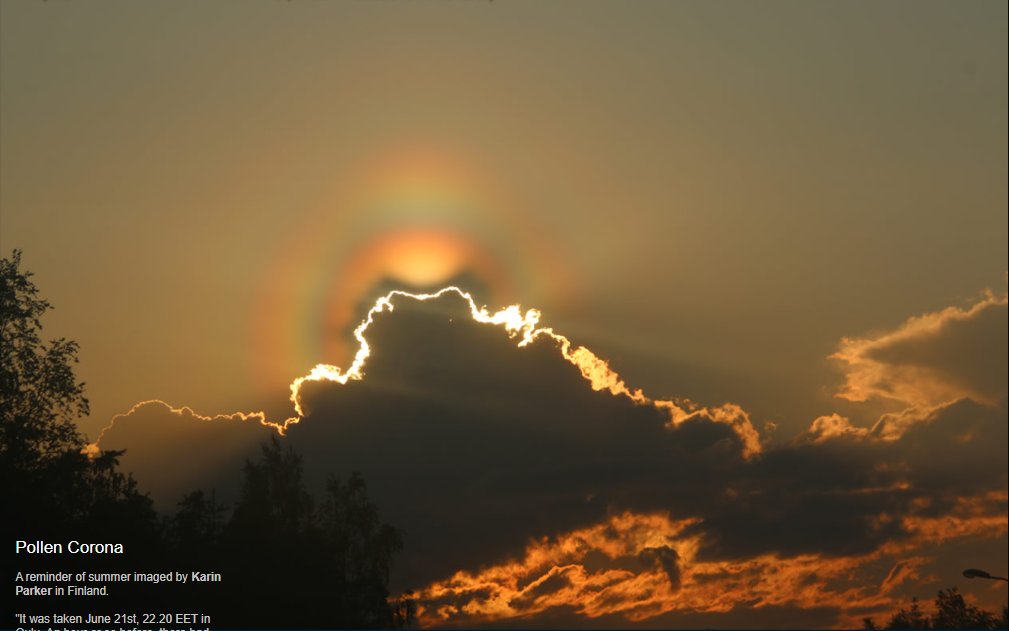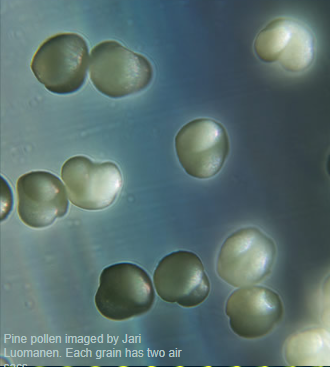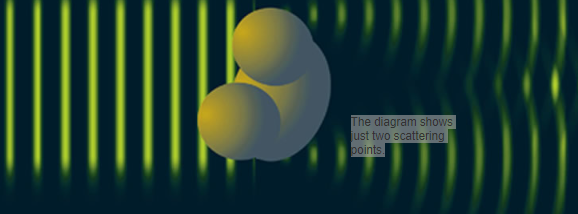Pollen Corona, Finland - OPOD
Pollen Corona: A Captivating Display of Nature's Artistry
Have you ever witnessed a mesmerizing spectacle in the sky that left you in awe of nature's artistry? One such breathtaking phenomenon is the Pollen Corona, captured in Finland by the talented photographer Karin Parker. This ethereal image, taken on June 21st at 22:20 EET in Oulu, serves as a vivid reminder of the vibrant summer season. Let's delve deeper into the enchanting world of pollen coronae and explore the captivating science behind this captivating atmospheric optics phenomenon.
A Serendipitous Encounter with Nature's Beauty
Karin Parker stumbled upon this enchanting sight after a sudden rain shower. As mist settled on the ground, the sun emerged from behind the clouds, casting its golden rays upon the landscape. In that precise moment, Karin was captivated by the remarkable sight and hastily captured this photograph, untouched by any post-processing techniques. The delayed pine pollen season in Finland had finally arrived, blanketing the surroundings with a green dust that perfectly complemented the atmospheric conditions, resulting in this awe-inspiring image.
Unraveling the Complexity of Pollen Coronae
Beyond its superficial resemblance to a corona caused by small water droplets, the pollen corona holds its own unique charm. At the edges of optically thin clouds, tiny water droplets scatter light, creating a delicate "silver lining" effect. However, in the case of pollen coronae, there is an added dimension of complexity. Pollen grains from the same plants possess identical sizes, leading to more saturated colors and multiple sharply defined rings. These rings exhibit vibrant hues that add to the visual splendor of this atmospheric marvel.
The Intricate Dance of Light and Pollen Grains
The opaque or translucent nature of pollen grains does not hinder their ability to form coronae. When light waves interact with the surface of these grains, they scatter in various directions, creating a fascinating phenomenon. Each scattering point on a pollen grain emits a train of spherical waves that overlap with one another. In certain directions, the wave crests coincide and reinforce each other, resulting in the presence of light. Conversely, in other angles, the waves cancel each other out, leading to darkness. This intricate dance of light and darkness gives rise to the diffraction pattern we observe as the pollen corona.
The Unique Symmetry of Pollen Coronae
While some pollen coronae exhibit an oval shape with brighter patches, not all follow this pattern. The orientation of pollen grains plays a crucial role in determining the shape and symmetry of the resulting diffraction pattern. Grains with air sacs, aiding in their wind dispersal, influence the orientation of the grains. Consequently, the diffraction pattern deviates from circular symmetry, resulting in oval coronae with distinct bright patches. This diversity in shape adds an element of surprise and wonder to each pollen corona sighting.
Exploring the Delicate Structure of Pine Pollen
To gain a deeper understanding of pollen coronae, let's take a closer look at pine pollen, imaged by Jari Luomanen. Each pine pollen grain possesses two air sacs, contributing to its unique structure. These sacs aid in the dispersal of pollen through wind currents, allowing them to travel great distances. When these specialized grains interact with light, their distinct shape and composition enhance the vibrant colors and well-defined rings observed in pollen coronae.
Appreciating the Beauty and Complexity of Nature
The enchanting phenomenon of the pollen corona serves as a reminder of the intricate beauty and complexity that nature offers. As we gaze upon these captivating displays in the sky, we are transported into a realm where science and art intertwine seamlessly. Whether it's the delicate scattering of light waves or the symmetrical arrangement of pollen grains, each element contributes to the grand spectacle that unfolds above us.
In conclusion, the pollen corona captured in Finland is a testament to the wonders that await us in the natural world. It is a testament to the intricate interplay between light and pollen grains, resulting in a breathtaking display of colors and rings. As we continue to explore and appreciate atmospheric optics phenomena like the pollen corona, we gain a deeper appreciation for the boundless beauty and complexity that surrounds us. So, next time you find yourself in the midst of a pine pollen season or witness a delicate silver lining around clouds, take a moment to marvel at the exquisite artistry of nature's pollen coronae.

Pollen Corona
A reminder of summer imaged by Karin Parker in Finland.
"It was taken June 21st, 22.20 EET in Oulu. An hour or so before, there had been sudden rain and there was mist on the ground. The sun was breaking through the clouds when I saw this and pulled the car over in shock to get the photo. The pine pollen season had been delayed a little here in Finland because of the weather, but a week previously the green dust started appearing in large quantities so I guess the conditions were just right.
There's been no post processing at all- this is just off the camera card."
Corona image ©Karin Parker, shown with permission
More than a corona. At the optically thin cloud edges, small water droplets are scattering (diffracting) light to produce a 'silver lining'.
The shadow? The cloud is casting its shadow through lower mist. The viewing angle and position makes it appear above the cloud.
Bright. Colourful. Several oval rings. Bright patches. Sneezing. Very likely a pollen corona rather than the more commonplace one from small water droplets.
Pollen grains from the same plants are of identical size. That produces the more saturated colours and multiple sharper rings.
Some, but not all, pollen coronae are oval with brighter patches. The grains producing them have air sacs to aid wind dispersal and the sacs orient the grains. the resulting diffraction pattern no longer has circular symmetry.

Pine pollen imaged by Jari Luomanen. Each grain has two air sacs.
Pollen grains are opaque, or at most translucent. That does not affect their ability to form coronae.
Light waves scatter from their surface. Each scattering point gives a train of outgoing spherical waves. The waves overlap. In directions where the wave crests coincide they reinforce and there is light. At other angles the waves cancel one another and there is darkness. The resulting diffraction pattern is the corona.

The diagram shows just two scattering points.
Note: this article has been automatically converted from the old site and may not appear as intended. You can find the original article here.
Reference Atmospheric Optics
If you use any of the definitions, information, or data presented on Atmospheric Optics, please copy the link or reference below to properly credit us as the reference source. Thank you!
-
<a href="https://atoptics.co.uk/blog/pollen-corona-finland-opod/">Pollen Corona, Finland - OPOD</a>
-
"Pollen Corona, Finland - OPOD". Atmospheric Optics. Accessed on November 26, 2024. https://atoptics.co.uk/blog/pollen-corona-finland-opod/.
-
"Pollen Corona, Finland - OPOD". Atmospheric Optics, https://atoptics.co.uk/blog/pollen-corona-finland-opod/. Accessed 26 November, 2024
-
Pollen Corona, Finland - OPOD. Atmospheric Optics. Retrieved from https://atoptics.co.uk/blog/pollen-corona-finland-opod/.